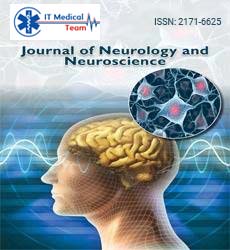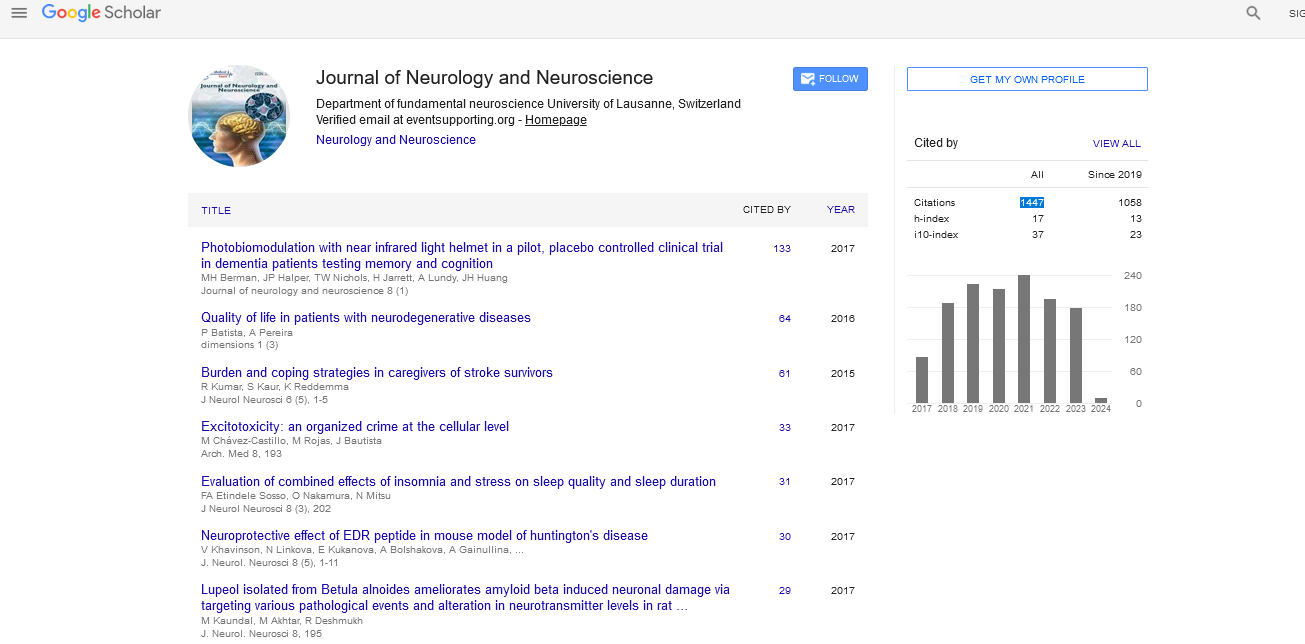Short Communication - (2024) Volume 15, Issue 6
Post-traumatic stress disorder and its long-term effects
Halisa Brine*
School of Allied Health Science, Griffith University, Brisbane, Australia
*Correspondence:
Halisa Brine, School of Allied Health Science, Griffith University, Brisbane,
Australia,
Email:
Received: 27-Nov-2024, Manuscript No. ipjnn-25-15494;
Editor assigned: 29-Nov-2024, Pre QC No. P- 15494;
Reviewed: 13-Dec-2024, QC No. Q-15494;
Revised: 18-Dec-2024, Manuscript No. R-15494;
Published:
25-Dec-2024
Abstract
Post-Traumatic Stress Disorder (PTSD) is a mental health condition that is triggered by experiencing or witnessing a traumatic event. While it is a natural human response to feel fear or anxiety after a traumatic experience, PTSD occurs when the individual’s response becomes persistent and significantly disrupts daily life. It can affect anyone, regardless of age, gender, or background, and often manifests in the weeks, months, or even years after the traumatic event. The long-term effects of PTSD can be profound, affecting mental, physical, and emotional health, as well as relationships and quality of life. Understanding these long-term effects is crucial for those suffering from PTSD, their families, and healthcare providers, as it allows for more effective treatment and support.
INTRODUCTION
Post-Traumatic Stress Disorder (PTSD) is a mental health condition that is triggered by experiencing or witnessing a traumatic event. While it is a natural human response to feel fear or anxiety after a traumatic experience, PTSD occurs when the individual’s response becomes persistent and significantly disrupts daily life. It can affect anyone, regardless of age, gender, or background, and often manifests in the weeks, months, or even years after the traumatic event. The long-term effects of PTSD can be profound, affecting mental, physical, and emotional health, as well as relationships and quality of life. Understanding these long-term effects is crucial for those suffering from PTSD, their families, and healthcare providers, as it allows for more effective treatment and support.
DESCRIPTION
PTSD is characterized by a range of symptoms that emerge after a person has been exposed to a traumatic event such as violence, abuse, war, natural disasters, or serious accidents. The condition can develop after a single event or prolonged exposure to trauma, such as in the case of ongoing abuse or combat. Intrusive memories include flashbacks, nightmares, and involuntary memories of the traumatic event, which can make the individual feel as though they are reliving the trauma. Avoidance and numbing, individuals may avoid places, people, or activities that remind them of the trauma. They may also withdraw emotionally, experiencing feelings of detachment or numbness. PTSD can lead to feelings of guilt, shame, anger, or hopelessness. There may be persistent negative thoughts about oneself or others, along with difficulty feeling positive emotions Hyperarousal includes symptoms like being easily startled, feeling tense or “on edge,” having difficulty sleeping, and experiencing irritability or angry outbursts. While these symptoms are generally categorized into specific groups, PTSD affects each person differently. For some, the symptoms might be manageable or temporary, while for others, they can become chronic, leading to significant long-term challenges [1]. The long-term effects of PTSD can ripple throughout many areas of an individual’s life. The longer the condition goes untreated, the more pervasive its impact can be. Below are some of the most common and serious longterm effects of PTSD. Chronic Anxiety and Depression: One of the most common long-term effects of PTSD is the development of other mental health conditions such as chronic anxiety and depression. PTSD survivors may live in a constant state of fear, anticipating danger even in safe environments, leading to heightened levels of anxiety. Depression is another common companion to PTSD, with individuals feeling hopeless about the future 2 − © J Neurol Neurosci 1. Sundeep S, Tarrier N, O'Neill P, et al. Does post-traumatic stress disorder occur after stroke: A preliminary study. Int J Geriatr Psychiatry. 1998;13:315-322. 2. Mirza KAH, Bhadrinath BR, Goodyer IM et al. Post-traumatic stress disorder in children and adolescents following road traffic accidents. Br J Psychiatry. 1998;172:443-447. 3. Yann A. Post-traumatic psychiatric disorders: PTSD is not the only diagnosis. La Presse Médicale. 2018;47:423-430. 4. Jane M. Post-traumatic stress disorder in people with learning disability. Adv Psychiatr Treat. 2001;7:163-169. 5. Richard B. Post-traumatic stress disorder vs. traumatic brain injury. Dialogues Clin Neurosci. 2022;13:251-262. and burdened by the emotional scars of their trauma. These conditions can lead to a decrease in motivation, loss of interest in daily activities, and difficulty functioning normally in society. Suicidal Thoughts and Behaviors: Unfortunately, PTSD significantly increases the risk of suicidal ideation and behavior. Individuals may feel overwhelmed by their emotions, and the persistent suffering from PTSD can lead them to view suicide as a way to escape. Studies show that people with PTSD are more likely to attempt suicide compared to those without the condition. It is crucial for individuals with PTSD to have a support system and access to professional mental health resources to prevent these severe outcomes. Substance Abuse, to cope with the intense emotional pain associated with PTSD, individuals may turn to alcohol or drugs. Substance abuse becomes a maladaptive coping mechanism, providing temporary relief from intrusive memories and emotional numbness. However, this can lead to addiction, worsening the symptoms of PTSD, and complicating treatment. Over time, substance abuse can damage relationships, employment, and overall health, deepening the individual’s struggles [2,3]. PTSD is not only a mental health issue; it also has significant effects on physical health. The chronic activation of the body’s stress response can lead to longterm health problems, such as cardiovascular disease, chronic pain, and autoimmune disorders. The increased levels of stress hormones like cortisol and adrenaline that accompany PTSD may raise the risk for conditions like high blood pressure, heart disease, and gastrointestinal problems. As a hallmark symptom of PTSD, sleep disturbances can persist long after the trauma has occurred. Individuals may experience insomnia, frequent waking, or disturbing nightmares that prevent restorative sleep. Over time, these disruptions can lead to chronic sleep deprivation, which in turn can exacerbate other physical health problems and affect mood, concentration, and daily functioning. Sleep disturbances, coupled with unhealthy coping mechanisms such as emotional eating, can also increase the risk of obesity. Chronic stress affects the body’s metabolic processes, contributing to weight gain or difficulty losing weight. Additionally, individuals suffering from PTSD may lack the energy or motivation to engage in physical activity, further increasing the likelihood of weight gain [4]. PTSD can cause individuals to withdraw from their families, friends, and communities. The emotional numbness, fear, and hyperarousal symptoms associated with PTSD can make it difficult to connect with others. People suffering from PTSD may also feel ashamed or embarrassed about their symptoms, which can prevent them from seeking help or talking about their experiences. This isolation can worsen their condition, leading to feelings of loneliness and alienation. PTSD often puts a strain on relationships, both romantic and familial. Partners may struggle to understand the behavioral and emotional changes their loved one is experiencing, such as irritability, anger, and emotional withdrawal. Children of parents with PTSD may feel neglected or scared, and family members may experience secondary trauma. Marital problems, such as increased conflict, divorce, or separation, are common in families where one member suffers from PTSD. The effects of PTSD can make it difficult for individuals to maintain steady employment. The emotional and cognitive impairments caused by PTSD, such as difficulty concentrating, memory problems, and irritability, can interfere with job performance. Furthermore, individuals may find it challenging to cope with the stress of a workplace environment or the pressures of meeting deadlines. This can lead to absenteeism, reduced productivity, or even job loss. Although the long-term effects of PTSD can be severe, it is important to emphasize that recovery is possible. Treatment for PTSD typically involves a combination of therapies, medications, and support systems to help individuals manage their symptoms and improve their quality of life. Cognitive Behavioral Therapy (CBT) is one of the most effective therapeutic approaches for treating PTSD. It helps individuals identify and change negative thought patterns and behaviors related to the trauma. Traumafocused CBT specifically addresses the trauma itself and helps individuals process their emotions, memories, and reactions in a safe and structured environment [5].
CONCLUSION
The long-term effects of PTSD can be life-altering, impacting not only the individual’s mental and emotional well-being but also their physical health, relationships, and overall quality of life. Understanding these effects is essential for addressing the complex needs of those who suffer from this disorder. While PTSD can have profound and lasting consequences, treatment options are available that can help individuals reclaim their lives and work towards healing. Through a combination of therapy, medication, and strong support systems, those suffering from PTSD can experience recovery and build a fulfilling life despite the challenges they face.
REFERENCES
<ol>
<li><a name="1" id="1"></a><strong>Sundeep S, Tarrier </strong><strong>N</strong><strong>, O'Neill </strong><strong>P</strong><strong>, et al.</strong> <a href="https://onlinelibrary.wiley.com/doi/abs/10.1002/(SICI)1099-1166(199805)13:5%3C315::AID-GPS766%3E3.0.CO;2-P" target="_blank">Does post‐traumatic stress disorder occur after stroke: A preliminary study</a>. <em>Int J Geriatr Psychiatry</em>. 1998;13:315-322.</li>
<p align="right"><a href="https://scholar.google.com/scholar?hl=en&as_sdt=0%2C5&q=Does+post%E2%80%90traumatic+stress+disorder+occur+after+stroke%3A+a+preliminary+study&btnG=" target="_blank"><u>Google Scholar</u></a>, <a href="https://doi.org/10.1002/(sici)1099-1166(199805)13:5%3C315::aid-gps766%3E3.0.co;2-p" target="_blank"><u>Crossref</u></a>, <a href="https://pubmed.ncbi.nlm.nih.gov/9658264/#:~:text=Conclusions%3A%20The%20results%20of%20this,syndrome%20can%20occur%20after%20stroke." target="_blank"><u>Indexed at</u></a></p>
<li><a name="2" id="2"></a><strong>Mirza KAH, Bhadrinath BR, Goodyer IM et al.</strong> <a href="https://www.cambridge.org/core/journals/the-british-journal-of-psychiatry/article/posttraumatic-stress-disorder-in-children-and-adolescents-following-road-traffic-accidents/B8ED3AED0674F460F85B98C832DDDA4B" target="_blank">Post-traumatic stress disorder in children and adolescents following road traffic accidents</a>. <em>Br J Psychiatry</em>.1998;172:443-447.</li>
<p align="right"><a href="https://scholar.google.com/scholar?hl=en&as_sdt=0%2C5&q=Post-traumatic+stress+disorder+in+children+and+adolescents+following+road+traffic+accidents&btnG=" target="_blank"><u>Google Scholar</u></a>, <a href="https://doi.org/10.1192/bjp.172.5.443" target="_blank"><u>Crossref</u></a>, <a href="https://pubmed.ncbi.nlm.nih.gov/9747409/" target="_blank"><u>Indexed at</u></a></p>
</ol>





